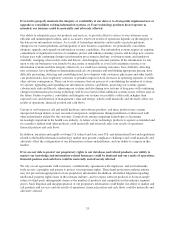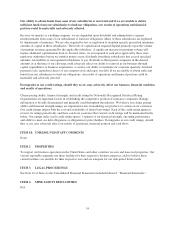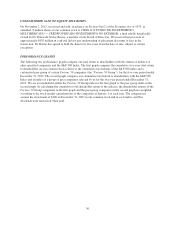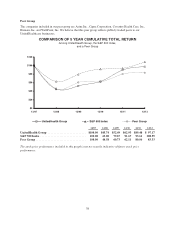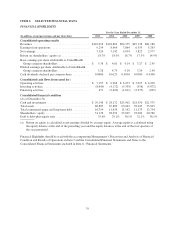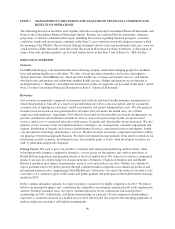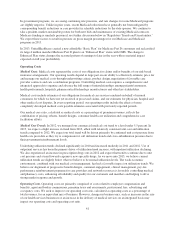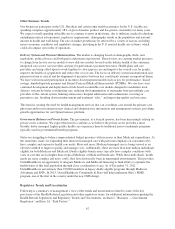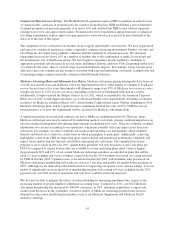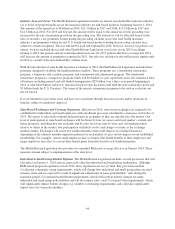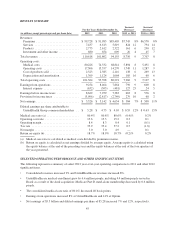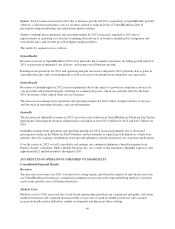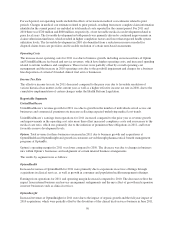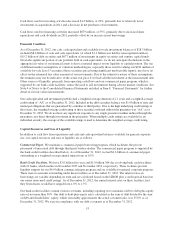United Healthcare 2012 Annual Report Download - page 45
Download and view the complete annual report
Please find page 45 of the 2012 United Healthcare annual report below. You can navigate through the pages in the report by either clicking on the pages listed below, or by using the keyword search tool below to find specific information within the annual report.Commercial Rate Increase Review. The Health Reform Legislation requires HHS to maintain an annual review
of “unreasonable” increases in premium rates for commercial health plans. HHS established a review threshold
of annual premium rate increases generally at or above 10% and clarified that HHS review will not supersede
existing state review and approval procedures. Premium rate review legislation (ranging from new or enhanced
rate filing requirements to prior approval requirements) has been introduced or passed in more than half of the
states as of the date of this report.
The competitive forces common in our markets do not support unjustifiable rate increases. We have experienced
and expect to continue to experience a tight, competitive commercial pricing environment. Further, our rates and
rate filings are developed using methods consistent with the standards of actuarial practices. We anticipate
requesting rate increases above 10% in a number of markets due to the combination of medical cost trends and
the incremental costs of health care reform. We have begun to experience greater regulatory challenges to
appropriate premium rate increases in several states, including California and New York. Depending on the level
of scrutiny by the states, there is a broad range of potential business impacts. For example, it may become more
difficult to price our commercial risk business consistent with expected underlying cost trends, leading to the risk
of operating margin compression in the commercial health benefits business.
Medicare Advantage Rates and Minimum Loss Ratios. Medicare Advantage pricing benchmarks have been cut
over the last several years and additional cuts were implemented in 2012, with changes to continue to be phased
in over the next one to five years (benchmarks will ultimately range from 95% of Medicare fee-for-service rates
in high cost areas to 115% in low cost areas), depending on the level of benchmark reduction in a county.
Additionally, Congress passed the Budget Control Act of 2011, which as amended by the American Taxpayer
Relief Act of 2012, would trigger automatic across-the-board budget cuts (sequestration), including a reduction
in outlays for Medicare starting in March 2013, absent further Congressional action. Further, beginning in 2014,
Medicare Advantage plans will be required to have a minimum medical loss ratio of 85%. CMS has not yet
issued guidance as to how this requirement will be calculated for Medicare Advantage plans.
A significant portion of our network contracts are tied to Medicare reimbursement levels. However, future
Medicare Advantage rates may be outpaced by underlying medical cost trends, placing continued importance on
effective medical management and ongoing improvements in administrative costs. There are a number of annual
adjustments we can and are making to our operations, which may partially offset any impact from these rate
reductions. For example, we seek to intensify our medical and operating cost management, adjust members’
benefits and decide on a county-by-county basis in which geographies to participate. Additionally, achieving
high quality scores from CMS for improving upon certain clinical and operational performance standards will
impact future quality bonuses that may offset these anticipated rate reductions. The expanded stars bonus
program is set to expire in 2014. In 2015, quality bonus payments will only be paid to 4 and 5 star plans per
PPACA (compared to current bonuses that are available to certain qualifying plans rated 3 stars or higher).
Approximately 60% and 10% of our current Medicare Advantage members are enrolled in plans that will be
rated 3.5 stars or higher and 4 stars or higher, respectively for the 2014 payment year based on scoring released
by CMS in October 2012. Updated scores, to be released in October 2013, will determine what portion of our
Medicare Advantage membership will reside in a 4 star or 5 star plan and qualify for quality bonus payments in
2015. Although we are dedicating substantial resources to improving our quality scores and star ratings, if we are
unable to significantly increase the level of membership in plans with a rating of 4 stars or higher for the 2015
payment year, our 2015 results of operations and cash flows could be adversely impacted.
We also may be able to mitigate the effects of reduced funding by increasing enrollment due, in part, to the
increasing number of people eligible for Medicare in coming years. Compared to 2011, our 2012 Medicare
Advantage membership has increased by 400,000 consumers, or 18%, including acquisitions. Longer term,
market wide decreases in the availability or relative quality of Medicare Advantage products may increase
demand for other senior health benefits products such as our Medicare Supplement and Medicare Part D
insurance offerings.
43


